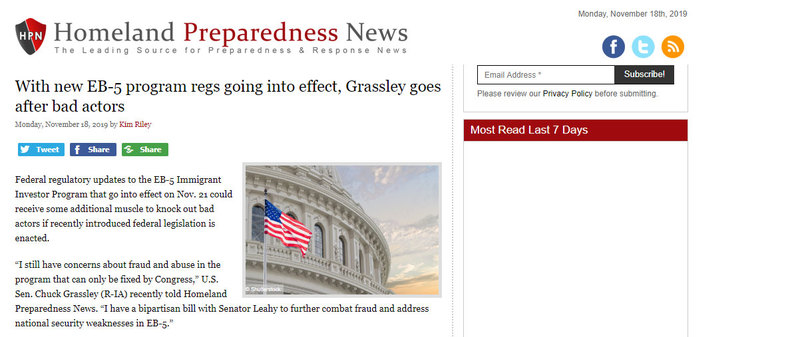With new EB-5 program regs going into effect, Grassley goes after bad actors
Federal regulatory updates to the EB-5 Immigrant Investor Program that go into effect on Nov. 21 could receive some additional muscle to knock out bad actors if recently introduced federal legislation is enacted.
“I still have concerns about fraud and abuse in the program that can only be fixed by Congress,” U.S. Sen. Chuck Grassley (R-IA) recently told Homeland Preparedness News. “I have a bipartisan bill with Senator Leahy to further combat fraud and address national security weaknesses in EB-5.”
Sens. Grassley and Patrick Leahy (D-VT) in September introduced the bipartisan EB-5 Reform and Integrity Act of 2019, S. 2540, which would reauthorize the EB–5 Regional Center Program to prevent fraud, while also promoting and reforming foreign capital investment and job creation in American communities.
Introduction of the Grassley/Leahy bill closely followed a final rule issued in July by the U.S. Department of Homeland Security’s (DHS) U.S. Citizenship and Immigration Services (USCIS) to reform the EB-5 program.
The final rule amends DHS regulations governing the employment-based, fifth preference (EB-5) immigrant investor classification and associated regional centers to reflect statutory changes and to modernize the EB-5 program.
“The EB-5 regulations that USCIS rolled out earlier this year and that take effect on November 21st are an important step in modernizing the program, cracking down on corruption and ensuring investments go to places that need them most,” said Sen. Grassley. “We need both the regulations and the legislation to fix the flaws in EB-5 and ensure that it works as Congress intended when it was created in the 1990s.”
The senator also explained that the EB-5 program regulations were first pursued during the Obama administration “and President Trump was able to deliver on them,” he said.
David North, a fellow at the Center for Immigration Studies and an internationally recognized authority on immigration policy, agreed.
“The new regs reflect both the thinking of the Obama administration and the acceptance of its suggestion by the current administration, a rare defacto bit of bipartisanship,” North told Homeland Preparedness News. “Its main improvement over the current system is that it makes it harder to put money into prosperous downtown areas through a tighter set of requirements for the Targeted Employment Areas (TEAs).
“This means that more of the money would go into rural and non-coastal areas, which is why the current EB-5 industry dislikes it. TEAs are areas where EB-5 funds can be invested,” said North.
If enacted, the Grassley-Leahy bill would reauthorize the EB-5 Regional Center Program through 2024 and would provide increased authority to DHS to deny or terminate program applications where there is fraud, criminal misuse or a threat to public safety or national security, according to a one-page summary of the bill provided by Sen. Grassley’s office.
Among many other provisions, the Grassley-Leahy measure also would permit investors to preserve their immigration process even if they have been defrauded.
The increasing number of bad actors, the senator said, spurred him to continue his EB-5 program reform fight.
Bad actors in South Dakota, for instance, for years took advantage of the EB-5 program, which grants green cards to eligible immigrants and their family members who invest $500,000 — soon to be $900,000 under the new regulations taking effect this week — in a new American commercial enterprise that produces at least 10 stateside jobs.
Government officials for the Mount Rushmore State consistently promoted the EB-5 program, even as numerous EB-5 state projects went bankrupt and foreign investors lost tens of millions of investment dollars.
In fact, several South Dakota state officials were charged for misusing both state government and EB-5 funds. One official, a former state cabinet member in the office of then-South Dakota Gov. Mike Rounds, now the Republican senator representing the state in Congress, apparently committed suicide for his supposed role in South Dakota’s EB-5 catastrophe, which began unfolding during the waning days of Rounds’ governorship.
Similar EB-5 fraudulent activity has been reported in several states, including Virginia, New York and Pennsylvania, among others.
“We need both the regulations and the legislation to fix the flaws in EB-5 and ensure that it works as Congress intended when it was created in the 1990s,” said Sen. Grassley.
On Nov. 5, Sen. Rounds introduced the Immigrant Investor Program Reform Act, S. 2778, with cosponsors U.S. Sens. Lindsey Graham (R-SC) and John Cornyn (R-TX) to strengthen the EB-5 Regional Center Program, in part through combating program abuse and bad actors.
Suzanne Lazicki, an EB-5 expert and blogger/owner of Lucid Professional Writing, explained that the Grassley and Rounds bills represent two points of view about the EB-5 program and what it should accomplish.
“Grassley wants to see EB-5 used as a catalyst for development in rural and urban distressed areas. The Rounds bill represents the faction that wants to allow EB-5 to continue to flow freely to good projects without undue location prejudice,” Lazicki wrote in an email.
The core conflict, she explained, is over the issue of TEAs — how they should be defined, and what incentives should be offered.
Until now, EB-5 has had a TEA policy with a robust incentive (a 50-percent discount off the minimum investment amount), but a loose definition (most areas could find a way to qualify), according to Lazicki. She noted that the EB-5 Modernization Regulation taking effect this week changes the TEA policy to give a robust TEA incentive (still the 50-percent discount), plus a restrictive TEA definition that would exclude many prosperous urban areas.
“This change could allow TEAs to become a competitive advantage for urban and rural distressed areas seeking EB-5 investment, and Senator Grassley supports it. Therefore, S. 2450 does not include additional TEA provisions,” she wrote in her email.
The people behind Rounds’ bill oppose TEA changes in the regulation, and instead offer a TEA policy designed to ensure that a wide variety of urban areas remain competitive for EB-5 investment at minimum levels, Lazicki wrote, adding that this would be accomplished by counterbalancing tightened TEA definitions with weakened incentives to invest in a TEA (a 9-percent discount and a visa set-aside incentive with limited practical efficacy).
“The reason that the Grassley bill is better, much better, is because it does not contain these two elements of the Rounds bill: a perpetuation of the current rules (to be overturned by the new regs), which permit the use of EB-5 funds in wealthy urban settings, and another provision that would terminate, in this one part of the immigration system, the long-standing concept of numerical limits on immigration,” North said.
Specifically, added North, the Rounds bill would cause the parole of some 73,000 “new and rich” immigrants, thus foiling the 10,000-a-year limit currently in effect.
“This would set a dangerous precedent for other parts of the immigration system,” North said.
Mentions
Litigation Cases
States
- New York
Securities Disclaimer
This website is for informational purposes only and does not constitute an offer or solicitation to sell shares or securities. Any such offer or solicitation will be made only by means of an investment's confidential Offering Memorandum and in accordance with the terms of all applicable securities and other laws. This website does not constitute or form part of, and should not be construed as, any offer for sale or subscription of, or any invitation to offer to buy or subscribe for, any securities, nor should it or any part of it form the basis of, or be relied on in any connection with, any contract or commitment whatsoever. EB5Projects.com LLC and its affiliates expressly disclaim any and all responsibility for any direct or consequential loss or damage of any kind whatsoever arising directly or indirectly from: (i) reliance on any information contained in the website, (ii) any error, omission or inaccuracy in any such information or (iii) any action resulting therefrom.




